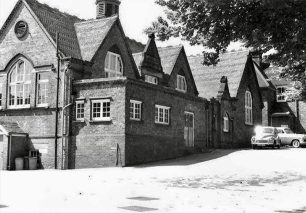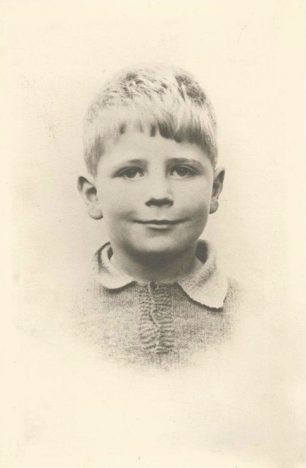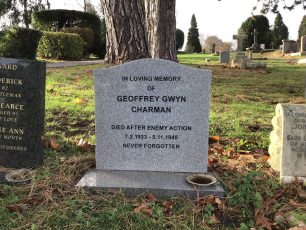The Bombing of Chaldon Rd, 4th November, 1940.
At 2.00pm, on the 4th November, 1940, a lone enemy bomber attacked Caterham on the Hill dropping several bombs which damaged shops and houses, and opening fire on children leaving the Council School, (now Hillcroft School).
No warning had been sounded, so the local Air Raid Precautions services had not been mobilised. The nearest front-line services were at Caterham Valley, 1 1/2 miles away. However Rescue Party Leader Samuel Chapman, a Builder’s Foreman who lived in Chaldon Road, was working on Westway Common, about 200 yards away, with other Council employees who were also off-duty members of the ARP services. They saw the bomber emerge from clouds, circle at low altitude and open fire with machine guns as its bombs fell.
Chapman wasted no time in organising assistance, firstly by deputising some of the men working with him to marshal the large number of children leaving the Council School to shelter. He commandeered a lorry, directed the driver to unload in a side street and be ready for immediate service. The bombs were still falling as the men reached the scene of the incident and discovered that there had been casualties. Chapman sent another lorry to Westway Depot, as he knew Sister Blackhouse of the Caterham Hill Casualty Service was there. She came to the scene with another nurse and rendered first aid to the casualties within a few minutes. Finally, Chapman and his co-workers inspected the damaged buildings for casualties, sent for stretchers and placed a guard on a damaged gas main. Thanks to his prompt action the incident was under control before the standby services arrived. He was recommended for a Civil Defence Gallantry award by Mr. P. E. Dimmock, the Clerk of Caterham Urban District Council on 27th November, 1940, though it isn’t clear what award he was given.
Mr. Matthias England Medwin, aged 47, died at the scene. Geoffrey Gwynn Charman, aged 7, succumbed to his injuries on the 5th November in Caterham Emergency Hospital.
The mention of commandeered lorries in the report of the aftermath of the bombing is interesting. Norman Skinner, one of the children caught in the street that day, sheltered from the bombing in one of the houses on the street – a lady had opened her front door and called the children inside. When he emerged after the raid, Norman found that his mother was in some distress as she had seen a blonde boy laid on the back of a lorry and had thought it was Norman – though it seems likely that it was little Geoffrey Charman.
At least one other boy was seriously injured. Mr. Ernest F. Hallpike, of 104 Chaldon Rd, was also seriously injured and died in Caterham Emergency Hospital on 1st December, 1940.
I think this piece from the BBC People’s War archive, by Derek Mould, describes the incident:
“Mother sent me to the local School at Caterham on the Hill. One day, there was no air raid warning, and just after leaving the School gates with many other children, I heard a heavy aircraft engine noise above in the low cloud, then machine gun fire, the bullets were all round us but it took a few moments for me to realise this, the constant cracking sound rather like cap guns, was in fact bullets hitting the ground, its a sound you never forget, there was a number of immediate bomb explosions, one in the middle of Chaldon Road that I was in, but further ahead up the road, which killed our grocer Mr Medwin who came out to the door of his corner shop at where the bomb fell, another bomb landed outside the gates of the Guards Barracks nearby, by that time I panicked and ran up to a house and I knocked on the door and the people let me come in to take shelter. A German bomber was brought down that same day which I believe was the same one described hitherto. Fighter planes from Kenley were scrambled, and I was told that one fighter literally flew up the exhaust pipe of the enemy aircraft and shot it down, it crashed on White Hill Chaldon about two miles from my home.”
No enemy bomber was brought down that day, as described above, – maybe this was a story to comfort the grief-stricken people of Caterham.
Another quote from the BBC People’s War Archive, this time from Peter Faggetter:
“But it’s the early 4th November incident at Caterham that held the tricky key to my; door. By the end of October the great B of B daylight raids had slowly faded away; the German hopes of an invasion during 1940 hadn’t proved possible due to our RAF resistance. Now the shorter days and autumn weather would, or was, hindering formation bombing, so the Germans were having to resort to small sections of planes or, on cloudier days, the single raiders. Such were difficult to keep track of or, even known about for in cloud they could meander with impunity until the time came to strike. It wasn’t a good day at school for lessons, and the dull November clouds only added more grey to what would be miserable morning. Due to air raid danger we were only schooling in the mornings – till 1 p.m. but I’d refuse to go. With my mother finally tiring of all my grumbles of not feeling well, and having a headache, she eventually gave in and crossly told me to stay in bed. Soon after the hour that would see the others leaving school the sound of an aircraft drew me outside our country bungalow. It was the first aeroplane I’d heard all morning, which wasn’t surprising considering the low, drab cloud base and that the sirens had remained silent. Assessing the passage of the in or above cloud aircraft’s movements in the direction of the Guards Barracks, I stood watching and waiting to see if it would appear. With the sounds of the twin-engine machine now moving to the right – and all within the space of two minutes, a Dornier dropped below the cloud in a shallow dive towards Caterham Hill, and then disappeared from my view behind the nearby obscuring tress. Seconds later sharp bomb detonations ripped through the air and tree branches from a mile away. In those moments a schoolmate I often walked part-way home with had one of the bombs explode almost alongside him. The bomb had landed in the road mid way between two well known little shops, one selling broken biscuits to the right lads and the other the sweets and fireworks specialist. The good man who I’m sure on occasions busted biscuits for the fun watching kids delighted faces was killed when, on hearing the bomber had rushed outside to pull my friend to safety. Another shop man was killed too, plus some kids injured. That was a ’banger’ to break more than all the biscuits, and battered the fireworks shop to a shambles.
So my morning refusal had paid off; as id by some extrasensory perception I’d given the Germans the slip. I certainly consider it as one of my great escapes for not only had my bored school instincts dictated my morning attitude to the day, but I was to actually spot the Dornier that carried the bomb with my name on it. Had I not that day been walking alongside Ray, I’d have been nearby and with the third member of our trio of classmates heading for westward homes. What’s more, I had heard it’s searching approach, then its reversing course, as if it had first overshot my usual whereabouts. And by another strange quirk of fate the other 13 yr old boy had been turned back at exit time by the awful science master, and to go up and clean a work surface in the science room; he’d brook no argument to the contrary either, apparently. More than a bit peeved, the lad was nevertheless glad and thankful when five minutes later he easily saw both the bomber and straddle of bombs exploding about where he would have been walking with Ray. He’d naturally wondered why I’d stayed off school that morning too. He thanks GOD for his most lucky escape, and coincidently – and learned when I was sixty years old – he married my school girlfriend! Ray’s injuries were quite severe for he had broken bones and lost and eye, and I never saw him again. Most people thought the bomber crew had been indiscriminate, but with the pilot needing the cloud shield against fighter attack, for perhaps he knew Kenley was close at hand, I’m inclined to think that he misjudged his timing to emerge from the cloud for an attack on the barracks.”
In memory of those killed as a result of this incident:
Matthias England Medwin, aged 47, of 98 Chaldon Road. Husband of Rhoda Blanche Medwin, died at 98 Chaldon Road. Mr. Medwin was buried in Caterham and Warlingham Cemetery (Grave ref: H.824).
Ernest Edwin Frederick Hallpike, aged 38, of 104 Chaldon Road. Husband of Kathleen Ellen Hallpike. Injured 4 November 1940, at Chaldon Road; died at Caterham Emergency Hospital. Mr. Hallpike was buried in Caterham and Warlingham Cemetery (Grave ref: H848).
Geoffrey Gwynn Charman, aged 7, son of Arthur and Ethel Charman, of 36 Wood Lane. Injured 4 November 1940, at Chaldon Road; died at Caterham Emergency Hospital. Geoffrey is buried at Caterham and Warlingham Cemetery.
https://www.cwgc.org/find-records/find-war-dead/casualty-details/3150157/GEOFFREY%20GWYNN%20CHARMAN/
Rest in peace…
Just felt the need to add my family’s story to the account of those events that fateful day.
BBC People’s War Archive: Article ID: A2228131, 23 January 2004














Comments about this page
My father Douglas Storey told me he was one of the children running from the gunfire. He remembers the plane flying along the road outside Hillcroft School and opening fire on him and the other children. He was one of the lucky ones. I knew he lost his best friend in war and this really affected him. I wonder if it was Geoffrey.
The current residents of Wood Lane heard the story of Geoffrey Charman and No36 has planted a rose bush in the front garden in his memory. The some of the residents would like to visit his memorial stone landed by Sarah Shoebridge‘s mother but unaware of it’s actually location. If anyone can help inform us of its location that would be great .
My Nan (now 93) was one of the children at Hillcroft school when this tragic event happened. She recounted the story dozens of times, and how awful it all was (I think this was her way of coping). She described hiding under the bushes at Westway Common and watching the bullets ripple along the ground literally right in front of her. And witnessing the bravery of Mr Matthias run out into danger to protect the little boy but both sadly losing their lives.
It’s a story that’s always stayed with me for obvious reasons. Over the last 15 years I’ve occasionally looked to find any records of this event and took a cursory glance today and thankfully found this page. Wishing everyone well.
Geoffrey was my mum’s cousin. I remember my gran had a picture of him among her things and a cut out from the local paper of the time with the photo shown above. We heard the story of poor Geoffrey and the shopkeeper when we were children and I can’t imagine what it must have been like for his parents.
Add a comment about this page